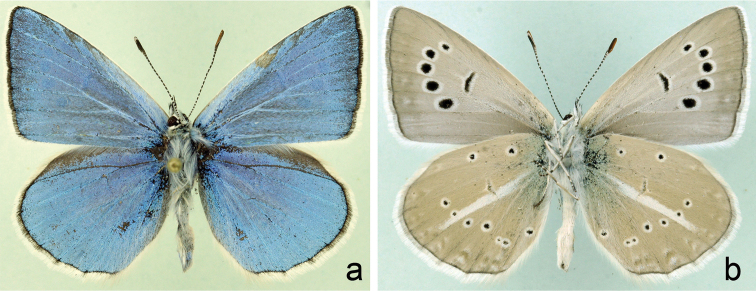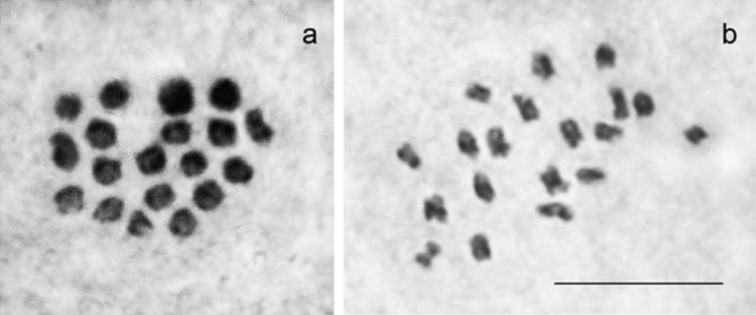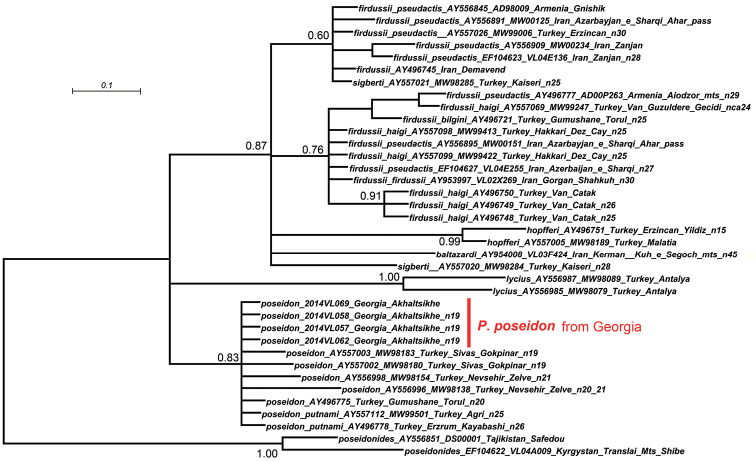Abstract Abstract
We show how combination of chromosomal and molecular markers can be applied for proper species identification in Agrodiaetus Hübner, 1822 blue butterflies. Using this approach we provide first evidence for presence of Polyommatus (Agrodiaetus) poseidon (Herrich-Schäffer, [1851]) in Georgia.
Keywords: Agrodiaetus, chromosome number, COI, karyotype, Lycaenidae, Polyommatus
Introduction
The blue butterfly subgenus Agrodiaetus Hübner, 1822 belongs to the genus Polyommatus Latreille, 1804 (Talavera et al. 2013). In the last years, this group become a model system for study of speciation and chromosome evolution (Lukhtanov et al. 2015, Vershinina et al. 2015). Despite this, its taxonomy is still poorly elaborated and identification of individual species is difficult due to their morphological similarity. Species within the subgenus are mostly uniform and exhibit few differences in characters traditionally used in classification, such as wing pattern and/or aspects of the male and female genitalia (Lukhtanov et al. 2006, Vila et al. 2010). The genus was estimated to have originated very recently (Kandul et al. 2004) and, thus, many Agrodiaetus species may have not had sufficient time to acquire extensive genetic differences. In particular, COI barcode gap is low or even absent between numerous closely related species of Polyommatus (Agrodiaetus) (Wiemers and Fiedler 2007). In opposite to majority of other butterflies and moths (Lukhtanov 2014), many Agrodiaetus species have evolved distinctive karyotypes. They show one of the highest interspecific karyotypic diversities known in the animal kingdom with haploid chromosome numbers ranging from n = 10 to n = 134 (Lukhtanov et al. 2005). Therefore, karyotypic features provide important identification characters for many described species that are virtually indistinguishable by their morphology. However, it should be noted that in few cases the chromosome number may be identical in different species (see Results and Discussion).
Here we show how combination of chromosomal and molecular markers can be applied for proper species identification in Agrodiaetus. Using this approach we provide first evidence for presence of Polyommatus (Agrodiaetus) poseidon (Herrich-Schäffer, [1851]) in Georgia.
Material and methods
The samples used for molecular and chromosomal analysis were collected in Georgia (Akhaltsikhe, 41.60N, 43.06E, 1000 m alt., 18 July 2014, V. Lukhtanov et V. Tikhonov leg., samples 2014VL56, 2014VL57, 2014VL58, 2014VL62, 2014VL63, 2014VL64, 2014VL65, 2014VL68, 2014VL69, 2014VL70). The methods of DNA sequencing, chromosomal analysis and phylogenetic inference were described previously (Lukhtanov and Dantchenko 2002a, Lukhtanov et al. 2008, 2014, Vershinina and Lukhtanov 2010, Przybyłowicz et al. 2014). Additional samples of Polyommatus belonging to Polyommatus (Agrodiaetus) poseidon species complex (Kandul et al. 2007) were used for comparison.
Results and discussion
The species Polyommatus (Agrodiaetus) poseidon (= Lycaena poseidon var. mesopotamica Staudinger, 1892, synonymized with Polyommatus poseidon by Schurian et. 1992) is known to be an endemic of the Middle East sporadically distributed from Kütahya in West Turkey to Artvin in North-East Turkey (Hesselbarth et al. 1995). Phenotypically similar, but chromosomally distinct species Polyommatus (Agrodiaetus) putnami (Lukhtanov & Dantchenko, 2002) was described from East Turkey (provinces Erzurum and Ağri) (Lukhtanov and Dantchenko 2002b). The last taxon is allopatric in distribution with Polyommatus (Agrodiaetus) poseidon and differs from Polyommatus poseidon by chromosome number and karyotype structure (Lukhtanov and Dantchenko 2002b). Polyommatus (Agrodiaetus) poseidon has relatively low haploid chromosome number (from n=19 on the south and east of the distributional range to n=21 in the north), all the chromosomes form a gradient size row with no especially large or small chromosomes (de Lesse 1963, Kandul and Lukhtanov 1997). Chromosome numbers n=22 and n=23 were also found in the northern population as intraindividual occasional deviations from the basic n=21 (de Lesse 1963). Polyommatus (Agrodiaetus) putnami has higher chromosome numbers (from n=24 to n=27, with n=26 as a distinct mode). Its karyotype is asymmetrical and includes chromosomes of two distinct classes: class of large chromosomes and class of small chromosomes (Lukhtanov and Dantchenko 2002b). Currently Polyommatus (Agrodiaetus) putnami is treated as a distinct species (Lukhtanov and Dantchenko 2002b, Wiemers 2003, Wiemers and Fiedler 2007) or a subspecies of Polyommatus (Agrodiaetus) poseidon (Tshikolovets 2011).
The taxon Polyommatus (Agrodiaetus) deebi (Larsen, 1974) discovered in Lebanon and Syria is often considered as a subspecies of Polyommatus (Agrodiaetus) poseidon (e.g. Tshikolovets 2011), however, it differs in chromosome number (n=17, Larsen 1975) and may represent a different species (Eckweiler and Häuser 1997). The taxon Polyommatus (Agrodiaetus) damocles krymaeus (Sheljuzhko, 1928) was also considered as subspecies of Polyommatus (Agrodiaetus) poseidon (Hesselbarth et al. 1995), however, with respect to mitochondrial genes COI and COII it is very distant from Polyommatus (Agrodiaetus) poseidon and was shown to be a subspecies of Polyommatus (Agrodiaetus) damocles (Herrich-Schäffer, [1844]) (Lukhtanov et al. 2005, Kandul et al. 2007).
Males of Polyommatus (Agrodiaetus) poseidon have plesiomorphic (Kandul et al. 2004, Lukhtanov et al. 2005) blue colouration of the upper side of the wings with no specific morphological characters. Therefore their morphological discrimination from phenotypically similar Polyommatus (Agrodiaetus) caeruleus (Staudinger, 1871), Polyommatus (Agrodiaetus) damocles and Polyommatus (Agrodiaetus) damonides (Staudinger, 1899) is difficult. With respect to COI barcodes, Polyommatus (Agrodiaetus) poseidon is indistinguishable from Polyommatus (Agrodiaetus) hopfferi (Herrich-Schäffer, [1851]) and Polyommatus (Agrodiaetus) putnami (Wiemers & Fiedler, 2007). As it was stated above, the chromosome number varies within Polyommatus (Agrodiaetus) poseidon (de Lesse 1963, Kandul and Lukhtanov 1997, Lukhtanov and Dantchenko 2002b) and thus overlap with chromosome numbers found in Polyommatus (Agrodiaetus) elbursicus (Forster, 1956), Polyommatus (Agrodiaetus) cyaneus (Staudinger, 1899), Polyommatus (Agrodiaetus) ectabanensis (de Lessse, 1963), Polyommatus (Agrodiaetus) hamadanensis (de Lesse, 1959), Polyommatus (Agrodiaetus) alcestis (Zerny, 1932), Polyommatus (Agrodiaetus) altivagans (Forster, 1956), Polyommatus (Agrodiaetus) mithridates (Staudinger, 1878), Polyommatus (Agrodiaetus) shirkuhensis ten Hagen et Eckweiler, 2001 and Polyommatus (Agrodiaetus) pierceae (Lukhtanov & Dantchenko, 2002) (Kandul et al. 2007, Lukhtanov et al. 2014).
A population of blue butterflies which were morphologically similar to Polyommatus (Agrodiaetus) poseidon (Fig. 1) was discovered near Akhaltsikhe in Georgia in 2013 by V.Tikhonov and I. Kostyuk. In 2014 the locality was visited again in order to collect material available for molecular and chromosomal study. Molecular analysis of this material revealed that COI barcodes were completely identical or nearly identical (barcode gap from 0 to 0.6%) in population from Akhaltsikhe and other populations of Polyommatus (Agrodiaetus) poseidon and Polyommatus (Agrodiaetus) putnami (Fig. 2).
Figure 1.

Polyommatus (Agrodiaetus) poseidon from Akhaltsikhe, Georgia. a male, upperside b male, underside.
Figure 2.
Bayesian tree of the species close to Polyommatus (Agrodiaetus) poseidon inferred from COI sequences. Posterior probability values >50% are shown.
The haploid chromosome number n=19 was found in MI and MII cells of three studied individuals (2014VL57, 2014VL58, 2014VL62) (Fig. 3). All chromosome elements formed a gradient size row. The karyotype contained no exceptionally large or small chromosomes. In this respect, the population from Akhaltstikhe is indistinguishable from populations of Polyommatus (Agrodiaetus) poseidon from Amasya (de Lesse 1963) and Artvin (Kandul and Lukhtanov 1997), but differs from Polyommatus (Agrodiaetus) putnami (n=26) (Lukhtanov and Dantchenko 2002b).
Figure 3.

Male karyotype of Polyommatus (Agrodiaetus) poseidon from Georgia. a sample 2014VL57, metaphase I, n = 19 b sample 2014VL62, metaphase II, n = 19. Bar = 10 μm.
Thus, although in the studied case neither the DNA barcodes nor chromosomal numbers are species-specific characters, their combination clearly indicates that the population from Akhaltsikhe should be identified as Polyommatus (Agrodiaetus) poseidon. This is the first evidence of Polyommatus (Agrodiaetus) poseidon for Georgia and for Caucasus region at whole.
Acknowledgements
We thank Igor Kostyuk (Kiev State University) for participation in the trip to Georgia The financial support for this study was provided by the grant from the Russian Science Foundation N 14-14-00541 to Zoological Institute of the Russian Academy of Sciences.
Citation
Lukhtanov VA, Tikhonov VV (2015) Chromosomal and molecular evidence for presence of Polyommatus (Agrodiaetus) poseidon (Lepidoptera, Lycaenidae) in Caucasus region. Comparative Cytogenetics 9(2): 249–255. doi: 10.3897/CompCytogen.v9i2.5020
References
- de Lesse H. (1963) Variation chromosomique chez les Agrodiaetus [Lep. Lycaenidae]. Revue Française d’Entomologie 30(3): 182–189. [Google Scholar]
- Eckweiler W, Häuser C. (1997) An illustrated checklist of Agrodiaetus Hübner, 1822, a subgenus of Polyommatus Latreille, 1804 (Lepidoptera, Lycaenidae). Nachrichten des Entomologischen Vereins Apollo, Supplement 16: 113–168.
- Hesselbarth G, Van Oorschot H, Wagener S. (1995) Die Tagfalter der Türkei unter Berücksichtigung der angrenzenden Länder. Vol. 1-3 Selbstverlag S. Wagener, Bocholt, 1354 pp. [Google Scholar]
- Kandul NP, Lukhtanov VA. (1997) Karyotype variability and systematics of blue butterflies of the species groups Polyommatus (Agrodiaetus) poseidon and Polyommatus (Agrodiaetus) dama (Lepidoptera, Lycaenidae). Zoologichesky Zhurnal 76(1): 63–69. [Google Scholar]
- Kandul NP, Lukhtanov VA, Dantchenko AV, Coleman JWS, Sekercioglu CH, Haig D, Pierce NE. (2004) Phylogeny of Agrodiaetus Hübner 1822 (Lepidoptera: Lycaenidae) inferred from mtDNA sequences of COI and COII and nuclear sequences of EF1-α: Karyotype diversification and species radiation. Systematic Biology 53(2): 278–298. doi: 10.1080/10635150490423692 [DOI] [PubMed] [Google Scholar]
- Kandul NP, Lukhtanov VA, Pierce NE. (2007) Karyotypic diversity and speciation in Agrodiaetus butterflies. Evolution 61(3): 546–559. doi: 10.1111/j.1558-5646.2007.00046.x [DOI] [PubMed] [Google Scholar]
- Larsen TB. (1975) Chromosome numbers and notes on testicular morphology of some Lebanese Rhopalocera (Insecta: Lepidoptera). Entomologica Scandinavica 6(3-4): 253–260. doi: 10.1163/187631275X00091 [Google Scholar]
- Lukhtanov VA. (2014) Chromosome number evolution in skippers (Lepidoptera, Hesperiidae). Comparative Cytogenetics 8(4): 275–291 doi: 10.3897/CompCytogen.v8i4.8789 [DOI] [PMC free article] [PubMed] [Google Scholar]
- Lukhtanov VA, Dantchenko AV. (2002a) Principles of highly ordered metaphase I bivalent arrangement in spermatocytes of Agrodiaetus (Lepidoptera). Chromosome Research 10(1): 5–20. doi: 10.1023/A:1014249607796 [DOI] [PubMed] [Google Scholar]
- Lukhtanov VA, Dantchenko AV. (2002b) Descriptions of new taxa of the genus Agrodiaetus Hübner, [1822] based on karyotype investigation (Lepidoptera, Lycaenidae). Atalanta 33(1/2): 81–107, 224–225. [Google Scholar]
- Lukhtanov VA, Kandul NP, Plotkin JB, Dantchenko AV, Haig D, Pierce NE. (2005) Reinforcement of pre-zygotic isolation and karyotype evolution in Agrodiaetus butterflies. Nature 436(7049): 385–389. doi: 10.1038/nature03704 [DOI] [PubMed] [Google Scholar]
- Lukhtanov VA, Shapoval NA, Anokhin BA, Saifitdinova AF, Kuznetsova VG. (2015) Homoploid hybrid speciation and genome evolution via chromosome sorting. Proceedings of the Royal Society B: Biological Sciences 282(1807): . doi: 10.1098/rspb.2015.0157 [DOI] [PMC free article] [PubMed] [Google Scholar]
- Lukhtanov VA, Shapoval NA, Dantchenko AV. (2008) Agrodiaetus shahkuhensis sp. n. (Lepidoptera, Lycaenidae), a cryptic species from Iran discovered by using molecular and chromosomal markers. Comparative Cytogenetics 2(2): 99–114. [Google Scholar]
- Lukhtanov VA, Shapoval NA, Dantchenko AV. (2014) Taxonomic position of several enigmatic Polyommatus (Agrodiaetus) species (Lepidoptera, Lycaenidae) from Central and Eastern Iran: insights from molecular and chromosomal data. Comparative Cytogenetics 8(4): 313–322. doi: 10.3897/CompCytogen.v8i4.8939 [DOI] [PMC free article] [PubMed] [Google Scholar]
- Lukhtanov VA, Vila R, Kandul NP. (2006) Rearrangement of the Agrodiaetus dolus species group (Lepidoptera, Lycaenidae) using a new cytological approach and molecular data. Insect Systematics and Evolution 37(3): 325–334. doi: 10.1163/187631206788838563 [Google Scholar]
- Przybyłowicz Ł, Lukhtanov V, Lachowska-Cierlik D. (2014) Towards the understanding of the origin of the Polish remote population of Polyommatus (Agrodiaetus) ripartii (Lepidoptera: Lycaenidae) based on karyology and molecular phylogeny. Journal of Zoological Systematics and Evolutionary Research 52(1): 44–51. doi: 10.1111/jzs.12040 [Google Scholar]
- Schurian KG, van Oorschot H, van den Brink H. (1992) Polyommatus (Agrodiaetus) poseidon (H.-S.) und Polyommatus (Agrodiaetus) theresiae sp. nov. aus der Türkei (Lepidoptera: Lycaenidae). Nachrichten des Entomologischen Vereins Apollo 12(4): 217–232. [Google Scholar]
- Talavera G, Lukhtanov VA, Pierce NE, Vila R. (2013) Establishing criteria for higher-level classification using molecular data: the systematics of Polyommatus blue butterflies (Lepidoptera, Lycaenidae). Cladistics 29: 166–192. doi: 10.1111/j.1096-0031.2012.00421.x [DOI] [PubMed] [Google Scholar]
- Tshikolovets V. (2011) Butterflies of Europe & Mediterranean Area. Tshikolovets Publication, Pardubice, Czech Republic. [Google Scholar]
- Vershinina AO, Anokhin BA, Lukhtanov VA. (2015) Ribosomal DNA clusters and telomeric (TTAGG)n repeats in blue butterflies (Lepidoptera, Lycaenidae) with low and high chromosome numbers. Comparative Cytogenetics 9(2): 161–171. doi: 10.3897/CompCytogen.v9i2.4715 [DOI] [PMC free article] [PubMed] [Google Scholar]
- Vershinina AO, Lukhtanov VA. (2010) Geographical distribution of the cryptic species Agrodiaetus alcestis alcestis, A. alcestis karacetinae and A. demavendi (Lepidoptera, Lycaenidae) revealed by cytogenetic analysis. Comparative Cytogenetics 4(1): 1–11. doi: 10.3897/compcytogen.v4i1.21 [Google Scholar]
- Vila R, Lukhtanov VA, Talavera G, Gil-T F, Pierce NE. (2010) How common are dot-like distribution ranges? Taxonomical oversplitting in Western European Agrodiaetus (Lepidoptera, Lycaenidae) revealed by chromosomal and molecular markers. Biological Journal of the Linnean Society 101: 130–154. doi: 10.1111/j.1095-8312.2010.01481.x [Google Scholar]
- Wiemers M. (2003) Chromosome differentiation and the radiation of the butterfly subgenus Agrodiaetus (Lepidoptera: Lycaenidae: Polyommatus) a molecular phylogenetic approach. Ph.D. Dissertation, University of Bonn, Bonn, Germany, 203 pp http://hss.ulb.uni-bonn.de/2003/0278/0278.htm [Google Scholar]
- Wiemers M, Fiedler K. (2007) Does the DNA barcoding gap exist? – a case study in blue butterflies (Lepidoptera: Lycaenidae). Frontiers in Zoology 4: . doi: 10.1186/1742-9994-4-8 [DOI] [PMC free article] [PubMed] [Google Scholar]



